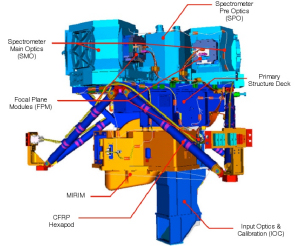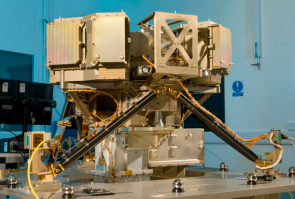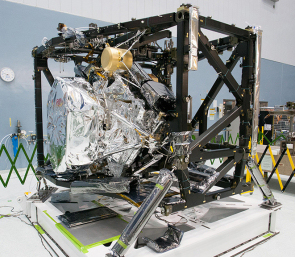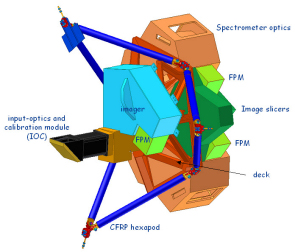MIRI - the mid-infrared instrument on JWST
MIRI - a versatile, mid-infrared instrument with wide-ranging capabilities
MIRI has capabilities needed for the whole range of JWST science, covering every phase of cosmic history from the high-redshift Universe through the formation of planetary systems to our own Solar System.
The science goals of JWST require a versatile mid-infrared instrument covering the 5-28.5 μm wavelength range with a wide field of view for imaging through broad and narrow band filters, low resolution spectroscopy from 5-10 μm, moderate resolution spectroscopy with R ~ 3000, and high dynamic range coronography. MIRI is designed to provide all of these functions in a single instrument.
The MIRI imaging mode has a plate scale of 0.11 arcsec/pixel, fully sampling the JWST point spread function at 5.6 μm, a field of view of 1.7 by 1.3 arcmin and 10 filters (see Table 1 of Wright et al., 2008 for details of the filters).
The MIRI coronagraphy mode has four coronagraphs operating at wavelengths selected for the optimal study of exoplanets. (The coronagraph filter bands are given in Table 1 of Wright et al., 2008.)
The MIRI medium resolution spectroscopy mode is an integral field spectrograph with R ~ 3000, covering 4.6-28.6 μm. This wavelength range has been divided into four channels with concentric fields of view on the sky, and each channel has three sub-bands with dedicated gratings, so that a complete spectrum of a 3.5 arcsecond × 3.5 arcsecond field of view can be obtained in three exposures. The details of spectral resolution, spatial resolution and fields of view for each of the spectrometer channels and the wavelength sub-bands are given in Table 2 of Wright et al., 2008. For low-resolution spectroscopy, the resolution is R ~ 100, with a five arcsecond slit.
Instrument overview
Due to the need to operate at mid-infrared wavelengths, MIRI must be cooled to a temperature of 7 K, much lower than the rest of the instruments on JWST, which will be at a temperature of 40 K. The instrument is therefore the only one to be cooled by a dedicated cooler. This makes it unique in its distribution across all three regions of the spacecraft, and brought additional challenges during the instrument's development. The MIRI optical system and the MIRI cooler system have followed different development paths, to take account of the different maturity levels of the technologies being employed.
The MIRI optical system
The MIRI optical system includes the opto-mechanical system known as the optical bench assembly (OBA); the instrument control electronics (ICE) to drive the mechanisms, read temperature sensors and similar tasks; the focal plane control electronics (FPE) to drive the detectors; and the MIRI flight software which configures and controls the instrument and handles the data flow between the hardware and the JWST Integrated Science Instrument Module (ISIM) flight software.
 |
|
MIRI optical bench assembly and key subsystems. Credit: University of Leicester, UK |
The instrument has a modular optical design and is an isothermal all-aluminium construction. The sub-assemblies have been designed to be testable in isolation. The optical bench assembly is both supported on, and thermally isolated from, the ISIM structure by a Carbon Fibre Reinforced Plastic (CFRP) hexapod. Isolation from the ISIM thermal environment is provided by custom designed Multi-Layer Insulation (MLI) blankets.
Optically, the instrument is divided into two channels - an imager channel, with one detector array and a spectrometer channel, which is further subdivided into long and short-wavelength modules - each having its own detector array. Both the imager and spectrometer channels are fed by common optics from a single pick-off mirror placed close to the JWST's focal plane.
A pick-off mirror in front of the JWST's optical telescope assembly focal plane directs the MIRI field-of-view towards the imager. A small fold mirror adjacent to the imager light path picks off the small (up to 8 × 8 arcsec) field-of-view of the spectrometer. A second fold in the spectrometer optical path is used to select either light from the telescope or from the MIRI calibration system.
The imager module has a combined field of view for the imager, coronagraph and low-resolution spectrometer modes. Coronagraph masks are placed at a fixed location on one edge of the imager field. The light is collimated and, at the pupil image formed by the collimator, a filter wheel holds the imaging filters, Lyot stops and filters for the coronagraph and a pair of prisms for the low-resolution, 5-10 μm spectroscopy. A camera then images the field (or spectrum) onto a single detector.
The medium resolution spectrometer module is split into a short-wavelength (~5 to 12 µm) and a long wavelength (~12 to 28 µm) spectrometer, each covers two of four wavelength channels split by dichroics. Each channel consists of an Integral Field Unit whose output is collimated and then dispersed by a dedicated first-order diffraction grating. The spectra from pairs of IFUs are combined by two cameras onto two detectors.
The spectrometer optics fall naturally into two subsystems - the spectrometer pre-optics, which consists of the system of dichroics and image slicers with associated fold and re-imaging mirrors, and the spectrometer main optics, which consists of the gratings and camera systems for the two spectrometers. Only one-third of the full spectral band covered by each channel is sampled in a single exposure. A pair of mechanisms (the Dichroic and Grating Assemblies, or DGA) is used to select gratings and the dichroics matched to each of the three sub-spectra. A full 5-28 μm spectrum requires three exposures to be made, one at each of the three positions of the two DGAs.
 |
|
The MIRI instrument during alignment tests. |
The fields of view for imaging and spectroscopy are defined and separated in the input optics and calibration sub-assembly, which also provides a calibration source for flat-field illumination of the imager. For calibration purposes the blackbody radiation is produced by micro-miniature tungsten filament lamps and is rendered uniform by a diffusing surface within an optical concentrator. The light is then re-imaged to a pupil placed in the shadow of the secondary mirror. An identical calibration source is also included in the spectrometer channel. The imager optics are supported on one side of the primary structure with the spectrometer optics on the other side, and all the mirrors and structures are of light-weight construction.
There are three wheel mechanism assemblies, based on designs and heritage from the Infrared Space Observatory (ISO); one in the imager and one in each channel of the spectrometer. The imager wheel carries both the filters for imaging and the coronagraph masks/filters. Each spectrometer wheel mechanism assembly has a pair of wheels mounted on either side of the mechanism: a wheel with dichroics that define the sub-bands of the spectrometer, and a wheel with the matching set of gratings. There is also a contamination control cover; used to protect the MIRI detectors and optical chain from contamination in flight during the observatory cool down process. The cover is also used to protect the detectors from saturation during the process of centring bright stars accurately behind the coronagraph masks.
The instrument control electronics (ICE), located in the warm spacecraft region, operates in cold redundancy and provides the capability for controlling the four mechanisms, processing mechanism position sensor and thermistor telemetry, and driving the calibration emitters. The ICE is connected to the ISIM Command and Data-Handling electronics (ICDH) by an MIL-STD-1553B bus, and responds to instrument configuration commands from the MIRI flight software.
The imager and the short and long wavelength spectrometer modules each have a Focal Plane Module (FPM) housing a single Sensor Chip Assembly (SCA) containing a 1024 × 1024 pixel Si:As detector array - with anti-reflective coatings applied to the detector to maximise the absorption for each instrument band - and readout electronics. The Focal Plane Electronics is a space-qualified electronics box located in a room temperature compartment on the ISIM, which responds to observation setup commands, produces the clocks and biases necessary to drive the detectors and read-out electronics, receives the analogue signals from the detectors, amplifies and digitises those signals, and transmits the science and housekeeping data to the ICDH. It receives setup commands for the individual FPM SCAs from the MIRI flight software, which is an instrument-specific application within the ICDH and its software hierarchy, communicating through a high speed SpaceWire interface. The FPE receives its power from the spacecraft Electrical Power Unit (EPU). The FPE also monitors and controls the temperature of each FPM and controls the detector annealing heaters, which may be used to help remove the effects of latent images.
MIRI's unique cooling system
The MIRI cooler system uses a 6 Kelvin Joule-Thomson cooler, pre-cooled by a three-stage pulse tube cryocooler to provide 65 mW of cooling at the instrument. MIRI's 6 K cooling load, directly behind the primary mirror of JWST, is remote from the location of the compressors and pre-cooler. This distance, and the parasitic heat load on the refrigerant lines spanning it, is accommodated by the design. Design and construction of the cooler system has been carried out by Northrop Grumman under contract to JPL.
 |
|
Cryocooler for MIRI. |
The Joule-Thomson compressor is based on a flight qualified High Efficiency Cooler (HEC) compressor. Reed valve modules have been added to the centre plate of the HEC compressor to produce a continuous flow of helium gas through the Joule-Thomson loop, producing 6 K cooling via the Joule-Thomson restriction.
The pulse tube pre-cooler is based on the largest of Northrop Grumman's product line of flight compressors, the High Capacity Cooler (HCC) compressor. The three-stage pulse tube cryocooler pre-cools the helium gas used in the Joule-Thomson cooling loop. Pre-cooling the helium gas for the Joule-Thomson cooler is achieved using three sections of recuperator and three thermal connections to the pulse tube cold head, one to the cold block of each of the stages of the cold head. The three sections span temperature ranges of 300-100K, 100-40 K, and 40-17 K.
The pre-cooler recuperator section, including pulse tube cold head stages, recuperator stages, heat exchangers, thermal straps, the thermal radiation shield and mechanical supports was recognised as a particularly challenging part of the design. The simultaneous requirement of providing structural robustness to withstand the launch vibrations, and low thermal parasitic loads, necessitated a careful balance to be achieved. Launch vibration and functional testing of the pre-cooler subassembly has demonstrated the successful design of this hardware.



